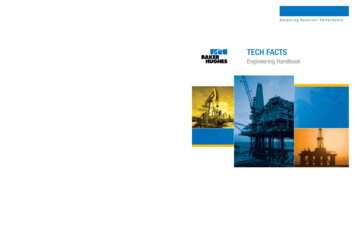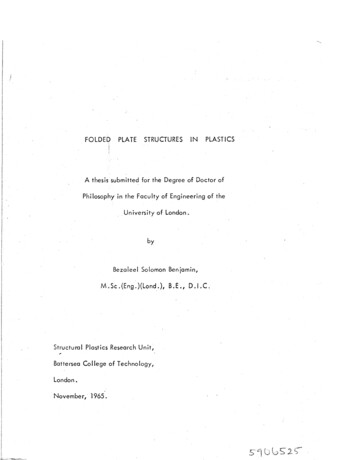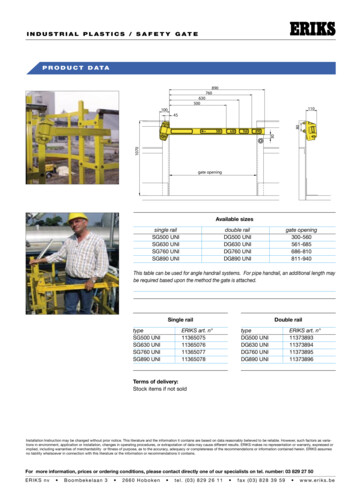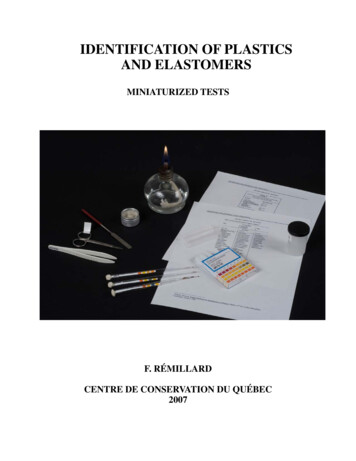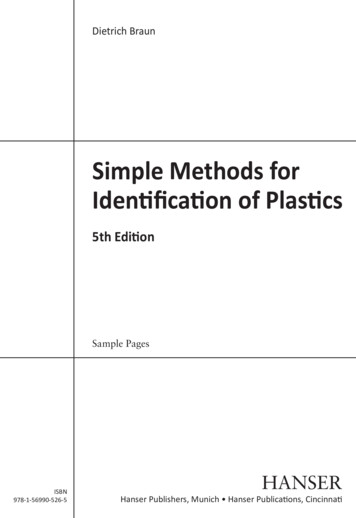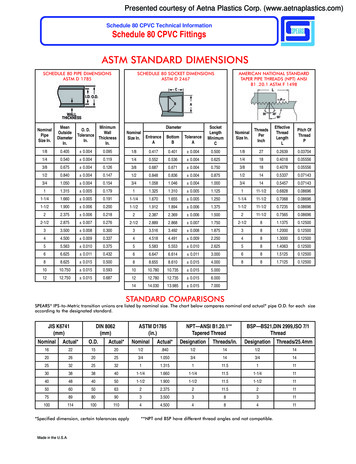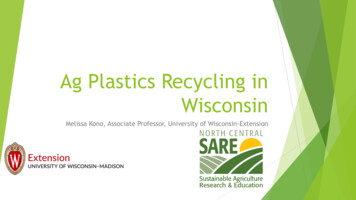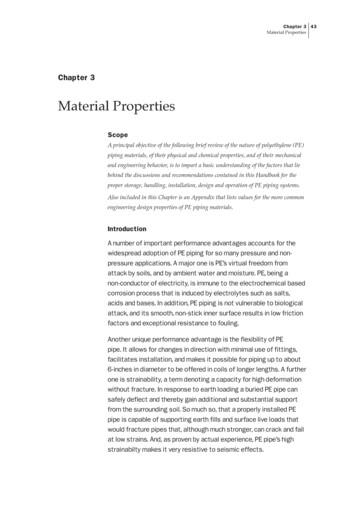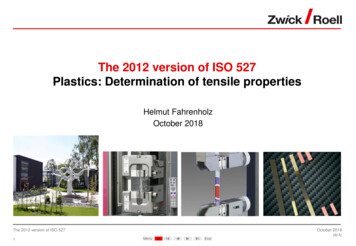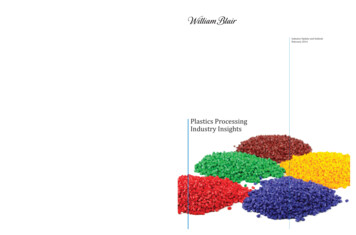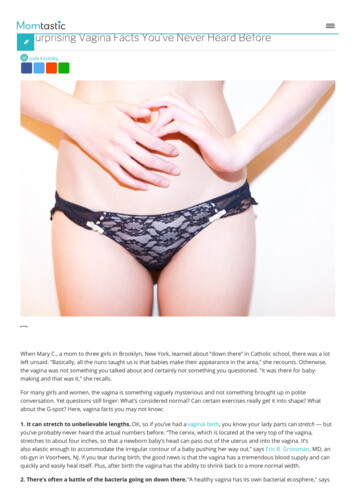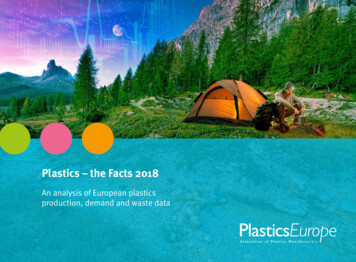
Transcription
Plastics – the Facts 2018An analysis of European plasticsproduction, demand and waste data
Plastics – the Factsis an analysis of the datarelated to the production,demand and wastemanagement of plasticmaterials. It provides the latestbusiness informationon production and demand,trade, recovery as well asemployment and turnover inthe plastics industry. In short,this report gives an insight intothe industry’s contributionto European economic growthand prosperity throughoutthe life cycle of the material.2
The data presented in this report was collected by PlasticsEurope(the Association of Plastics Manufacturers in Europe) and EPRO (theEuropean Association of Plastics Recycling and Recovery Organisations).PlasticsEurope’s Market Research and Statistics Group (PEMRG) providedinput on the production and the demand of plastic raw materials. ConversioMarket & Strategy GmbH helped assess waste collection and recoverydata. Official statistics from European or national authorities and wastemanagement organisations have been used for recovery and trade data,where available. Research or expertise from consultants completed gaps.Figures cannot always be directly compared with those of previous yearsdue to changes in estimates. Some estimates from previous years have beenrevised in order to track progress, e.g. for use and recovery of plastics acrossEurope over the past decade.All figures and graphs in this report show data for EU-28 plus Norway andSwitzerland, which is referred to as Europe for the purposes of abbreviation–other country groups are explicitly listed.3
Circularity at the heart of Europe’s economic transformationThe European Commission aims at transforming Europe into a more circular and resource efficient economy.PlasticsEurope fully supports this objective and believes plastic materials can help to achieve it.It is widely recognised that plastics have a crucial role toplay in delivering a more sustainable future. Through theirunique combination of light-weight, durability and otherintrinsic properties, plastic materials already contribute toreduce GHG emissions making a more efficient use of ourresources across a range of different sectors and everydayapplications. As a result of their versatility and capacityfor innovation, our materials are also invariably bestplaced to support breakthrough sustainable technologiesin areas such as sustainable mobility, smart and efficientbuilding, sustainable agriculture, food conservation or inthe healthcare and medical sector, to name only a few.However, challenges relating to littering and end-of-lifeoptions for certain types of plastics waste —especiallypackaging waste— must be addressed if the material isto achieve its fullest potential in a circular and resourceefficient economy.4It is in this spirit of commitment to future generations,that PlasticsEurope has decided to set a series ofambitious targets and initiatives up to 2030 that arefocussed on the key areas of preventing leakage of plasticsinto the environment, improving resource efficiency andincreasing recycling and reuse rates.With its Voluntary Commitment̏Plastics 2030 , PlasticsEurope isadvancing the plastics industry’s roleto a next level of engagement, recognisingthat this transformation will only takeplace through solutions put into realityand through the regulatory supportof the EU institutions.
“Plastics 2030”: making Circularity and Resource Efficiency a RealityThe Plastics 2030 Voluntary Commitment focuses on preventing leakage of plastics into the environment,0n improving resource efficiency and the circularity of plastic packaging applications.123Overarching goalsTargetsPrevent leakage of plastics into the environment.By increasing engagement inside and outside our industry.Improve resource efficiency.By accelerating innovation in the full life cycle of products.Improve circularity of plastic packaging.By reaching in 2040 100% reuse, recycling and/or recoveryof all plastic packaging in the whole EU.In 2030: 60% reuse and recycling of all plastic packaging.All play a role in a circular economyBuilding thDifferent plastics for different products6PackagingEnergy
Plastics make a veryefficient useof resources,Plasticproductionespecially duringthe use phaseProductmanufacturingAt the end of their life,ENERGYplasticsare still ngChemicalrecyclingREUSEREPAIREnergyrecoverythat can betransformed intonewfeedstockor into energyPost - Use7
“Plastics 2030”: making Circularity and Resource Efficiency a RealityGeneral commitmentsPrevent the leakage of plastics into the environment Prevent littering: identification and litteringprevention solution of most found items intothe environment.Improve resource efficiency and circularity of plastics Accelerate research of alternative feedstocks. Prevent pellet loss: Extension of waste data collection, includingnew data on circularity of plastics. Product Life Cycle Inventory: update of datasetsevery three years. Eco-design guidelines for plastic packagingfinalised by 2020.www.opcleansweep.eu Support standardisation for quality standardsfor sorted plastics.Global Plastics AllianceMarine Litter Solutions:355 projects in 47 countries.Global InitiativesWorld Plastics CouncilSupport of global initiativesand cooperation with UNEP, ticscouncil.org
Sector-specific commitments Development of packaging design guidelines and assessment protocols accordingto the principles of the Circular Economy. Innovation and standardisation to increase the recyclability of polyolefin packaging. EU wide quality standards for pre-sorted plastic waste, harmonisation of test methodsfor recycled plastic materials and certification of plastic recycling operations. Innovation & development of end-use markets to stimulate reuse and encouragedemand for recycled plastics. Stimulating innovation to improve recycling, conversion technologies and reuse. Develop technologies to recycle PS/EPS back into original applications. Collaborate with value chain to improve collection and sorting systemsfor packaging waste. Create an independent structure to finance promising technologies.www.styrenics-circular-solutions.com Within the framework of VinylPlus (www.vinylplus.eu) further advance and increasesafe and quality PVC recycling for all PVC applications. Continue developing eco-efficient PVC packaging materials, increasing shelf lifeof the packed products.ReportingMonitoring the progressof the voluntary commitment.Action plan and time-basedperformance indicators.Yearly evaluation providedby independent committee.9
Key figures of the European plastic industryThe European plastic industry includes plastics raw materials producers, plastics converters,plastics recyclers and plastics machinery manufacturers in the EU28 Member States.Over 1.5 million peopleThe plastic industry gives direct employmentto more than 1.5 million people in EuropeClose to 60,000 companiesJOBSAn industry in which close to 60,000 companiesoperate, most of them SME’sMore than 350 billion eurosCOMPANIESThe European plastic industry had a turnoverof 355 billion euros in 201717 billion eurosThe European plastic industry had a trade balanceof more than 17 billion euros in 2017** Data including only plastics raw materials producersTRADE BALANCE12and plastics convertersTURNOVER
More than 30 billion eurosThe European plastic industry contributed to 32.5 billioneuros to public finances and welfare in 2017PUBLIC FINANCESx2.4in GDP and almost x3 in jobsThe European plastic industry has a multiplier effectof 2.4 in GDP and almost 3 in jobs*MULTIPLIEREFFECT* The European House Ambrosetti study, data for Italy, 20137th in EuropeThe European plastic industry ranks 7th in Europe inindustrial value added contribution. At the same level as thepharmaceutical industry* and very close to the chemical industry* Measured by gross value added at factor prices, 2013INDUSTRIALVALUE ADDEDOver 8.4 million tonnesIn 2016, over 8.4 million tonnes of plastic waste werecollected in order to be recycled inside and outside the EURECYCLING13
Plastic or Plastics?Plastic is a term derived from the Latin “plasticus” which isderived from the Greek “plastikos” that was used to describesomething able to be molded or fit for molding. This terminologywas actually used already in the 17th century, long before the firstplastic material, Parkesine, was invented.Today “plastics” or “plastic materials” are the terms usedto describe an extremely large family of very different materialswith different characteristics, properties and uses.Thanks to their versatility and innovation capacity, plasticmaterials can offer customized solutions to a wide varietyof needs in innumerable products, applications and sectors.Plastics are not just one material, but a wide family of differentmaterials. Today they can be fossil-based or bio-based andin both cases they can also be bio-degradable.16
Discovering the wide family of plasticsThe plastics’ family is composed of a great variety of materials designedto meet the very different needs of thousands of end products.The two categories of plasticsThermoplasticsThermosetsare a family of plastics that can be melted when heatedand hardened when cooled. These characteristics, whichlend the material its name, are reversible. That is, it can bereheated, reshaped and frozen repeatedly.are a family of plastics that undergo a chemical change whenheated, creating a three dimensional network.After they are heated and formed these plastics cannotbe re-melted and reformed.Polyethylene (PE)Polycarbonate (PC)Polyurethane (PUR)Polypropylene (PP)Poly methyl methacrylate (PMMA)Unsaturated polyesterPolyvinyl-chloride (PVC)Thermoplastic elastomers (TPE)Epoxy resinsPolyethylene Terephthalate (PET)Polyarylsulfone (PSU)Melamine resinPolystyrene (PS)FluoropolymersVinyl esterExpanded polystyrene (EPS)PEEKSiliconeABSPOMPhenol - formaldeyhdeSANPBTUrea - formaldeyhdePolyamides (PA)Etc.Phenolic resinsAcrylic resinsEtc.17
World and EU plastics production dataThe world plastic* production almost reached 350 million tonnes in 2017.Source: PlasticsEurope Market Research Group (PEMRG) / Conversio Market & Strategy GmbHEUROPE(EU28 es64.4milliontonnes3482016Includes thermoplastics, polyurethanes, thermosets, elastomers, adhesives, coatings and sealants and PP-fibers.Not included PET-, PA- and polyacryl-fibers.2017milliontonnes
Distribution of global plastics productionChina is the largest producer of plastics, followed by Europe and NAFTA.World plastics* production: 348 million tonnes.Source: PlasticsEurope Market Research Group (PEMRG) / Conversio Market & Strategy GmbHAsiaEurope18.5%50.1%CIS2.6%NAFTA29.4% China17.7%3.9% Japan16.8% Rest of AsiaLatin America4%4%Middle East,Africa7.1%*Includes thermoplastics, polyurethanes, thermosets, elastomers, adhesives, coatings and sealants and PP-fibers.Not included PET-, PA- and polyacryl-fibers.19
A positive trade balance of more than 17 billion euros in 2017Source: EurostatPlastics manufacturing Extra EU28Plastics processing Extra 12bn Extra-EU exportsExtra-EU imports2014bn Extra-EU trade balanceExtra-EU exportsExtra-EU imports
Top Extra EU trade partners in valueThe European plastic industry has good and long-standing trading relationship with many countries.Source: EurostatTurkeyUnited StatesUnited StatesChinaRepublic of KoreaSaudi 99PlasticsmanufacturingUnited StatesSwitzerlandChinaTurkey1511972017 Extra EU ImportsChinaUnited smanufacturing2017 Extra EU ExportsPlasticsprocessing185TurkeyRepublic of Korea3791537%21
Plastic converter demand main market sectorsDistribution of European (EU28 NO/CH) plastic converter demand by segment in 2017.Source: PlasticsEurope Market Research Group (PEMRG) and Conversio Market & Strategy GmbH22
European plastic converter demand per countryGermany24.6%Italy14%FranceSpainUnited KingdomPoland9.6%7.7%7.3%6.5%The six larger European countries cover almost 70% of the Europeandemand in 2017Belgium & Lux.NetherlandsCzech uaniaDenmarkLatviaFinlandEstoniaSlovakiaCyprus & Maltaless than 500 ktCountries with morethan 3 million tonnesEuropean plastic converter demand includes plastic materials (thermoplastics and polyurethanes) and other plastics(thermosets, adhesives, coatings and sealants). Does not include: PET fibers, PA fibers, PP fibers and polyacryls-fibers.Source: PlasticsEurope Market Research Group (PEMRG) and Conversio Market & Strategy GmbHTotal European converter20172016demand51.2 m t23
Plastic converter demand main market sectorsDistribution of European (EU28 NO/CH) plastic converter demand by segment in 2017.Source: PlasticsEurope Market Research Group (PEMRG) and Conversio Market & Strategy GmbHTotal converter demandPACKAGING51.2 m tBUILDING & CONSTRUCTIONAUTOMOTIVE39.7 %10.1 %OTHERS19.8 %ELECTRICAL& ELECTRONICHOUSEHOLD,LEISURE & SPORTS4.1 %6.2 %24AGRICULTURE3.4 %medical equipment, plasticfurniture and furniture equipment,technical parts used for mechanicalengineering or machine-building, etc.16.7 %
Plastic converter demand by resin typeDistribution of European (EU28 NO/CH) plastic converter demand by resin type in 2017.Source: PlasticsEurope Market Research Group (PEMRG) and Conversio Market & Strategy GmbH012PP345678910mt51.2 m tPE-LD / PE-LLDPE-HD / PE-MDTotal converterPVCdemandPURPETPSEPSABS / SANPAPCPMMAOther thermoplasticsOther plastics2016201725
European plastic converter demand by polymer types in 2017Data for EU28 NO/CH.Source: PlasticsEurope Market Research Group (PEMRG)
Plastic or Plastics? Plastic is a term derived from the Latin “plasticus” which is derived from the Greek “plastikos” that was used to describe something able to be molded or fit for molding. This terminology was actually used already in the 17th century, long before the first plastic material, Parkesine, was invented.
